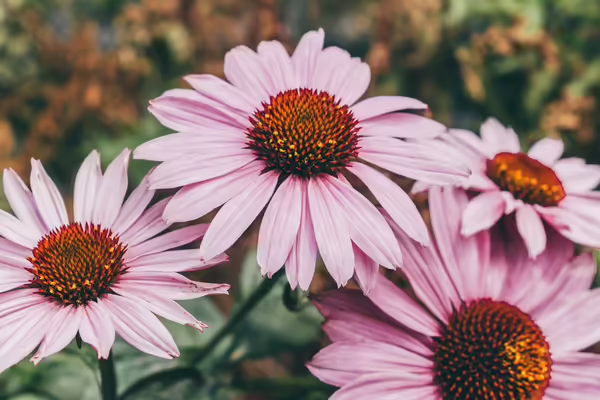
URBANA, Ill. — Many Illinois gardens are entering the fall stressed from the lack of summer rains combined with scorching hot temperatures. These conditions easily stress some plants; however, many plants quickly adapt to hot, dry conditions. Drought-tolerant plants are not only tough and dependable but also beautiful and functional in the landscape. When water is scarce and conserving resources is vital, consider planting drought-tolerant plants this fall that won’t require daily watering or care next summer.
A lack of water is a major stressor for plants. Although plants experience water stress due to a lack of rainfall or routine watering, they also lose water naturally through the pores in their leaves. During the process known as transpiration, the pores open to let carbon dioxide into the leaves for photosynthesis, but the open pores also allow water vapor to escape or evaporate. Signs a plant is stressed due to lack of water include curling leaves, chlorosis, also known as yellowing, stunted growth, and leaf scorch or drop.
Drought-tolerant plants adapt to dry conditions based on their ability to increase water absorption and conservation. With deep, well-developed root systems, these plants source water from deeper in the soil, which is beneficial during dry conditions. Many drought-tolerant plants have smaller leaves to reduce the leaf surface area, and less surface area means less exposure to water loss. Leaves are also protected from evaporation by either wax-coating or tiny hairs. Both types of leaves trap water and reduce the amount of water lost.
Regardless of growing conditions, selecting the right plant for the right place is the key to success in any garden. Always consider sunlight, soil, and site conditions before choosing plants for your landscape. Consider these species of plants that thrive in hot, dry conditions.
- Blue false indigo (Baptisia australis) is a large shrub-like perennial native to Illinois. Purple pea-like flower blooms in May, followed by dark brown seed pods atop the blue-green foliage. Its deep taproot makes it difficult to transplant; however, it is drought resistant and long-lived in the garden.
- Little bluestem (Schizachyrium scoparium) is a native prairie grass, well-adapted to Illinois conditions. Growing only 2 to 4 feet tall, it has fluffy seed heads for multiple seasons of interest in the garden. The bluish-green foliage transforms to copper in the fall.
- Threadleaf coreopsis (Coreopsis verticillata) is a 2 feet tall, clump-forming perennial with fine, feathery foliage. Yellow, daisy-like flowers bloom from May to July in Illinois. Deadhead or remove spent flowers to encourage a fall bloom and prevent plants from reseeding in the garden.
- Purple coneflower (Echinacea purpurea), a perennial native to Illinois, is adaptable to drought, heat, humidity, and poor soil. The dark green, coarse-leaved foliage grows 2 to 4 feet tall. Purple daisy-like flowers are present all summer, turning to brown spiked balls that overwinter in the garden as a food source for many songbirds.
Other dependable perennial plants that tolerate drought conditions include Russian sage, sedum, thread leaf coreopsis, showy goldenrod, liatris, monarda, Joe pye weed, blanket flower, and beardtongues.
Plant perennials in the fall at least six weeks before the first frost to ensure adequate time for roots to develop and the plant to acclimate to the landscape before cold winter temperatures. Although tough and dependable, these plants require some care and maintenance.
Just like any newly placed plant, water well the first year. Watering deeply but less frequently is better than shallow, more frequent watering, as deep watering encourages the roots to grow deeper. Most plants grow best with at least 1 inch of water per week. After drought-tolerant plants are established, watering will only be necessary to keep plants healthy if there is a prolonged period of dry weather.
Most drought-tolerant plants prefer well-drained soil because it encourages roots to spread as water drains away. Despite a preference, some soil moisture is still needed. Maintain soil moisture and cooler soil temperatures with shredded hardwood mulch. To reduce competition for soil, water, and nutrients, maintain a weed-free environment. Given these conditions, drought-tolerant plants need minimal fertilizer to thrive.
Try incorporating some of these drought-tolerant plants into the landscape to cut back on watering next summer. For more information on perennials and pruning, connect with a local Extension office at go.illinois.edu/ExtensionOffice.
Brittnay Haag is a Horticulture Educator with University of Illinois Extension, serving Livingston, McLean, and Woodford counties. Gardeners Corner is a quarterly newsletter from gardening experts around the state. Each issue highlights best practices that will make your houseplants, landscape, or garden shine in any season. Join the Gardener’s Corner email list at go.illinois.edu/GCsubscribe for direct access to timely tips.
PHOTO CREDIT: Kara Woods on Unsplash.com
Illinois Extension leads public outreach for University of Illinois by translating research into action plans that allow Illinois families, businesses, and community leaders to solve problems, make informed decisions, and adapt to changes and opportunities. Illinois Extension is part of the University of Illinois Urbana-Champaign College of Agricultural, Consumer and Environmental Sciences.